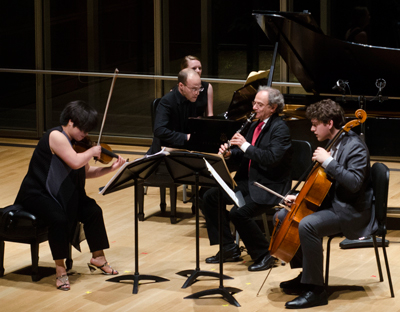by Daniel Hathaway

ChamberFest is an extended family affair that draws a number of close musical friends into its orbit, but its immediate family is Franklin, Diana and Alexander Cohen, an unusual trio of clarinet, violin and timpani for whom Matan Porat wrote an ingratiating festival fanfare entitled Start Time. Ringing changes on ChamberFest’s theme, (It’s) About Time, the short piece gave all three instruments a workout as they joined in and responded to one another after an arresting timpani solo.
The main work on Thursday evening’s program was Olivier Messiaen’s mystical Quartet for the End of Time, a work so emotionally intense that it can fill out an entire concert all by itself without the need for musical companionship. If the piece must be complemented by some other work, Mozart’s string quintet in g, K. 516 probably comes as close as any in its own era and musical language to Messiaen’s sense of daring and sublimity.
Violinists David McCarroll and Diana Cohen, violists Yura Lee and Dimitri Murrath and cellist Julie Albers gave the Mozart quintet a ruminative and lyrical reading — the first of two performances in the opening concerts, as the quintet also was scheduled for Friday’s concert at the Transformer Station. The Adagio was exquisitely wrought and the final Rondo chased away any remaining, pensive spirits with a burst of cheerfulness.
The circumstances surrounding the premiere of Messiaen’s Quatuor pour la fin du Temps in 1941 are well-known: a German army Stalag in Silesia in the dead of winter with prisoners of war and soldiers as audience and inadequate instruments in the hands of the composer and three friends. “Never was I listened to with such rapt attention and comprehension,” Messiaen wrote — except perhaps in Mixon Hall on Thursday evening, where the near-capacity audience could not have been more drawn in to that strange and visionary universe where the cosmology of John the Divine (author of the Christian Bible’s Book of Revelation) mixes seamlessly with Messiaen’s mystical Catholicism and fixation on the phenomena of the natural world. You don’t need to believe what Messiaen did to appreciate the Quartet on a deep level, but his music is so grippingly convincing that it leaves an indelible impression on the listener.
The Quartet for the End of Time is difficult and strenuous for the players, but Yura Lee, now playing violin, clarinetist Franklin Cohen, cellist Gabriel Cabezas and pianist Orion Weiss responded splendidly to its technical and emotional demands.
Weiss’s piano chords in the Liturgy of Crystal were “sparkling clouds” just as ordered. Cohen’s reading of the Abyss of the Birds was murky and masterful; his stealth attacks and long, measured crescendos gave a whole spectrum of color to impossibly long notes. The Dance of Fury for Seven Trumpets — a sophisticated study in additive rhythms for the four instruments playing in unison — was perfect in its ensemble and chilling in its effect. Both Cabezas and Lee had long, slow, ecstatic solo lines in movements dedicated respectively to the eternity and immortality of Jesus; they managed them adroitly, though tempos just a tick slower in each case (with a bit less vibrato) would have more closely suggested the timelessness Messiaen attempted to depict. The audience responded to the performance with an appropriately enthusiastic ovation.
An hour before the main event, Cabezas and Weiss played two works for cello and piano composed in the early years of the twentieth century: Leos Janacek’s rather impressionistic Pohádka (Fairy Tale) from 1910, and Claude Debussy’s neo-classical Sonata from 1915. Cabezas played with confidence and assured lyricism and Weiss expertly shadowed his musical gestures, though the piano, its lid fully raised, sometimes overbalanced the cello. The free, half-hour concert was a nice touch, even if it created the awkwardness of having the audience vacate the hall through a rarely-used exit and queue up again to re-enter.
Photo by Gary Adams.
Published on ClevelandClassical.com June 25, 2013
Click here for a printable version of this article.



